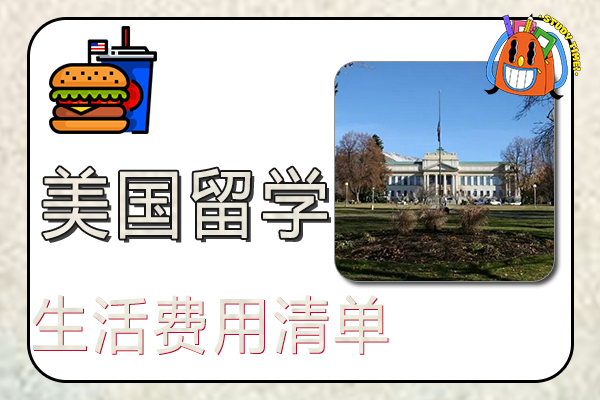Although there are many countries to study in, most people still have the United States as their main goal. The following is a list of information aboutList of living expenses for studying in New York and Los Angeles in the United States,Cost of living in the United States, ,Life of Chinese students in the United States, ,How much is the living cost of studying in the United States?, ,How to improve your study life in the United StatesThe problem.

Cost of living in New York and Los Angeles
Cost of living in New York and Los Angeles
1. New York:
1. Diet
A basic lunch in the business district (including drinks): $16 (¥104)
Fast food set meal (hamburger, cola, etc.): $8 (¥52)
500g chicken breast: $5.98 (¥38.87)
One liter of whole milk: $1.15 (¥7.47)
A dozen large eggs: $4.16 (¥27)
1 kg tomatoes: $5.22 (¥33.0)
1 kg of apples: $3.83 (¥25)
Half a liter of beer bought in a supermarket: $2.78 (¥18.07)
A bottle of red wine bought in a supermarket: $16 (¥104)
Two cans of Coke: $2.78 (¥18.07)
2. Housing
Rent a furnished apartment of 85 square meters in a high-end residential area. Monthly rent: $37 for better (¥24693)
Monthly rent for a furnished apartment of 85 square meters in an ordinary community: $2807 (¥18245)
Water, electricity, heating costs for two people in an 85 square meter apartment (month): $148 (¥962)
Monthly rent for a 45-square-meter furnished apartment in a high-end residential area: $2801 (¥18206)
Monthly rent for a 45-square-meter furnished apartment in an ordinary community: $1810 (¥11765)
Water, electricity, and heating costs for one person living in a 45-square-meter apartment: $98 (¥637)
8MB network: $54 (¥351)
40-inch flat-screen TV: $404 (¥2626)
3. Clothes
A pair of jeans (Levi's or similar): $53 (¥433)
A dress (Zara or similar): $43 (¥279.5)
A pair of sports shoes (Nike or similar): $94 (¥611)
A pair of leather shoes: $144 (¥936)
4. Transportation
A Volkswagen Golf: $26340 (¥171210)
One liter of gasoline: $0.7 (¥4.55)
Public transportation monthly pass: $117 (¥760.5)
Take a taxi to work (5 miles): $18 (¥117)
5. Personal items
Six days' worth of cold medicine: $9 (¥58.5)
12 antibiotic pills: $19 (¥123.5)
A short visit to a private doctor (15 minutes): $130 (¥845)
Female hygiene products: $9 (¥58.5)
Shampoo: $7 (¥45.5)
Four-roll toilet paper: $4.25 (¥11.7)
Basic men's haircut: $24 (¥156)
6. Entertainment
Eating out for two: $54 (¥351)
Two movie tickets: $30 (¥195)
Two theater tickets: $275 (¥1787)
Two people go to a high-end restaurant for dinner: $121 (¥786)
A cup of cappuccino: $14 (¥91)
A pack of Marlboro cigarettes: $14 (¥91)
One month gym membership: $97 (¥630)
2. Los Angeles:
1. Diet
A basic lunch in the business district (including drinks): $14 (¥91)
Fast food meal (hamburger, cola, etc.): $7 (¥45.5)
500g chicken breast: $5.45 (¥35)
One liter of whole milk: $1.02 (¥6.6)
A dozen large eggs: $4.84 (¥27)
1 kg tomatoes: $3.46 (¥22.5)
1 kg of apples: $3.14 (¥20)
Half a liter of beer bought in a supermarket: $3.21 (¥20)
A bottle of red wine bought in a supermarket: $13 (¥85)
Two cans of Coke: $2.52 (¥16)
2. Housing
Monthly rent for a furnished apartment of 85 square meters in a high-end residential area: $2568 (¥16692)
Monthly rent for a furnished apartment of 85 square meters in an ordinary community: $1771 (¥11511)
Water, electricity, heating costs for two people in an 85 square meter apartment (month): $156 (¥1014)
Monthly rent for a 45-square-meter furnished apartment in a high-end residential area: $1774 (¥11531)
Monthly rent for a 45-square-meter furnished apartment in an ordinary community: $1156 (¥7514)
Water, electricity, and heating costs for one person living in a 45-square-meter apartment: $89 (¥578)
8MB Network: $51 (¥331)
40-inch flat-screen TV: $435 (¥2827)
3. Clothes
A pair of jeans (Levi's or similar): $51 (¥331)
A dress (Zara or similar): $41 (¥266)
A pair of sports shoes (Nike or similar): $84 (¥546)
A pair of leather shoes: $125 (¥812)
4. Transportation
A Volkswagen Golf: $25161 (¥163546)
One liter of gasoline: $0.9 (¥5.85)
Public transportation monthly pass: $89 (¥578)
Take a taxi to work (5 miles): $17 (¥110)
5. Personal items
Six days' supply of cold medicine: $10 (¥65)
12 antibiotic pills: $22 (¥143)
A short visit to a private doctor (15 minutes): $130 (¥845)
Female hygiene products: $9 (¥58.5)
Shampoo: $5.78 (¥45.5)
Four-roll toilet paper: $4.25 (¥27)
Basic men's haircut: $21 (¥136.5)
6. Entertainment
Eating out for two: $44 (¥286)
Two movie tickets: $27 (¥175)
Two theater tickets: $176 (¥1144)
Two people go to a high-end restaurant for dinner: $92 (¥598)
A cup of cappuccino: $4.6 (¥30)
A pack of Marlboro cigarettes: $8 (¥52)
One month gym membership: $43 (¥280)
Further reading: Application process for studying in the United States
1. Take the exam
The first thing to start is English preparation, because when you go to study in the United States, you need to provide transcripts of qualified language standardized tests. Whether it is IELTS or TOEFL, you need to receive training in advance to familiarize and adapt to the model and content.
The recognition of both types of exams is very high, so you can just choose one type for intensive study. Basically, there are exams scheduled every week, so when you are preparing, you can agree on the exam time in advance to ensure that you can get the test results within the specified time.
2. Confirm your goals
You need to learn about the schools and majors you are applying for in advance, so you need to spend time screening, which is generally not very time-consuming. Because at least one of them will have a clear goal, and then you can conduct a comprehensive assessment based on planning, ability and ranking.
3. Prepare Materials
In the formal material preparation, you need to accumulate and prepare the hardware in advance, so when the time comes, you can directly obtain it. The academic certificate and GPA transcript, as well as the language test certificate, can be obtained directly after the date.
The statements and awards in the document preparation must be prepared according to the requirements, and fully demonstrate your true situation and explain your future study and employment plans. These are relatively complicated contents, and everyone must do them wholeheartedly.
Recommendation letters should also be taken very seriously, especially those written by people who need to be confirmed to be of relatively high status; other materials that prove one's ability, such as award certificates, internship certificates, published articles, etc., will all have a relatively positive effect and can increase the admission rate.
IV. Submit your application
Submit your application early to leave yourself enough time, and you will also get the final review results earlier. You don’t need to worry about missing the time. Because some majors are more popular, the channel will be closed when the number of students is full, so it is better to submit early.
The waiting time for review is about two months. During this period, you can keep in touch with the school to confirm the status of your material review to ensure that it goes smoothly. After receiving a satisfactory offer, you can directly confirm the admission.
Further reading: Recommended popular cities for studying abroad in the United States
1. Chicago
Chicago is located in Illinois, on the shores of Lake Michigan. It is the third largest city in the United States, the second largest commercial center, and an international futures trading center. Therefore, it is a good place for many finance and law students.
In addition, Chicago's industry, manufacturing, and tourism are also very developed, which is very suitable for students majoring in mechanical engineering, business administration, industrial engineering, etc. Chicago has four distinct seasons, with an average daily temperature of about 29°C in July and an average daily minimum temperature of about -11°C in January. The estimated living expenses are: 3,000-3,500 USD/month.
Recommended: University of Chicago, Northwestern University, University of Illinois, Illinois Institute of Technology, University of Illinois at Chicago, Chicago State University, Columbia School of the Art Institute of Chicago, etc.
2. New York
New York is the largest city in the United States. Its financial district is led by Lower Manhattan and Wall Street. It has diverse culture and a strong artistic atmosphere. It is also filled with a large number of financial institutions, making it the first choice for students of finance, art and media.
In addition, New York is also the headquarters of the United Nations and is known as the world's diplomatic center. Many large companies have their headquarters in New York, so the various opportunities and resources in New York are unmatched by most cities in the United States. Climate: Plenty of rain, pleasant weather, the average daily temperature in July is about 28℃, and the average daily minimum temperature in January is about -4℃. Estimated living expenses: $3,000-3,500/month.
Recommended: Columbia University, New York University, Pace University, State University of New York, Fordham University, etc.
3. Boston
Boston is located in an enviable geographical location, backed by mountains and facing the sea, close to New York, and is one of the oldest and most culturally valuable cities in the United States.
The entire Boston metropolitan area has more than 100 universities and hundreds of thousands of college students receiving education here. It has the highest density of colleges and universities in the world and is also home to many world-renowned research institutions. It concentrates a vast amount of education, culture, art, medical and employment resources.
Boston has four distinct seasons. Winters are cold and snowy. The average daily temperature in July is about 28°C, and the lowest daily temperature in January is about -6°C. Estimated living expenses: $3,000-3,500 per month
Recommended: Massachusetts Institute of Technology, Harvard University, Tufts University, Brandeis University, Boston College, Boston University, Northeastern University, Emerson College, Williams College, Berklee College of Music, etc.
4. Washington, D.C.
Washington is the political center of the United States. The White House, Congress, the U.S. courts, and most government agencies are located here. It is also the headquarters of international organizations such as the World Bank, the International Monetary Fund, and the Organization of American States. It also has numerous museums and cultural sites. Washington is a fertile ground for students studying media, public relations, and public policy. You will have the opportunity to deal with many government agencies and non-profit organizations. The temperature in the District changes relatively slowly, with an average daily temperature of about 31°C in July and an average daily minimum temperature of about -3°C in January. The estimated cost of living is: US$2,500-3,500/month.
Recommended: George Washington University, University of the District of Columbia, Georgetown University, Howard University, American University, etc.
5. Los Angeles
Los Angeles is the largest city in California and the base of the U.S. petrochemical, marine, aerospace and electronics industries. It is also one of the main centers of science and technology in the United States, ranking first in the country in terms of the number of scientists and engineering technicians.
Los Angeles is also a financial center second only to New York in the United States, with a well-developed financial and commercial industry. As the home of Hollywood, it is not difficult to bump into celebrities on the streets of Los Angeles. The development of creative industries, the prosperity of music, television and film, make Los Angeles a vibrant city. Los Angeles climate: mild throughout the year, with an average daily temperature of about 24°C in July and an average daily minimum temperature of about 9°C in January. Estimated living expenses: $2,500-3,500 per month.
Recommended: California Institute of Technology, University of California, Los Angeles, University of Southern California, California State University, Los Angeles, etc.
6. San Francisco
San Francisco is a port city on the Pacific coast of California, U.S. It is close to the high-tech industrial zone Silicon Valley, with developed electronics, software, and computer industries. Companies that are attractive to international students, such as Google, Apple, Facebook, and Intel, are all located here. It is the world's most important high-tech research and development base and the most important financial center in the western United States. It is a livable city that students of science, engineering, and finance aspire to.
Climate: warm in winter and cool in summer, with plenty of sunshine. The average daily temperature in July is about 22℃, and the average daily minimum temperature in January is about 5℃. Estimated living expenses: US$2,500-3,500/month.
Recommended: Stanford University, University of San Francisco, University of California, San Francisco, etc.
Further reading: Accommodation options for studying in the United States
1. Student dormitory
Student dormitories are mostly for freshmen who have just arrived. There are single rooms, double rooms and quad rooms. In terms of price, single rooms are the most expensive, followed by double rooms and quad rooms. Generally, student dormitories are located near the school, with convenient transportation and living. They are supervised by security personnel and are very safe. It is recommended that students choose student dormitories in their first year, which are affordable and cost-effective.
2. Apartment
Apartment buildings are similar to our domestic apartment buildings, the difference is that American apartments are wooden structures, and the height of the floors will not exceed five (taking California as an example). American apartments are similar to domestic communities, and the community with property management is the model. The comfort level is very high, and the community is equipped with swimming pools, gyms, entertainment halls, etc. The independence is also better than that of student dormitories, usually divided into one-bedroom, two-bedroom and three-bedroom. The price is slightly more expensive than student dormitories, ranging from US$1,500 to US$3,000. It is suitable for students who have been in the United States for more than two years or have good independence.
3. House-Independent Villa
As the name suggests, a large house is a stand-alone structure with a swimming pool and backyard (some do not). It usually has at least 3 bedrooms, 2 bathrooms, a separate living room and kitchen. The price starts at US$3,000, and the bigger the house, the more expensive it is. Generally, students must provide SSN (American Social Security Number) when renting a private house.
Students who usually choose a house share the rent with 4 or 5 people, which is very cost-effective. The average rent per person is about 700 per month. However, houses also have their troubles. You have to worry about the maintenance in the later stage, such as regular maintenance of the lawn, etc. However, the comfort level of a house is really high, which is suitable for a small team to live in.
Cost of living in New York and Los Angeles
Summary of living expenses in New York and Los Angeles
After understanding the cost of living list for studying in New York and Los Angeles in the United States, you will also need to prepare an online tool to bypass the firewall and return to China when studying in the United States.For many Chinese who go to the US to study and work, they still like to watch some Chinese TV series and programs in China, and they are more accustomed to use some domestic native apps to listen to music, watch videos, play games and so on. However, due to copyright reasons, most of the popular programs are only allowed to be accessed by mainland IPs. In such a big background, theBack to China via the InternetQuickFox is the best choice for overseas Chinese to return to China, access domestic websites or applications, enjoy domestic music and video resources, and solve copyright and regional restrictions with one click.














